庭園・茶室
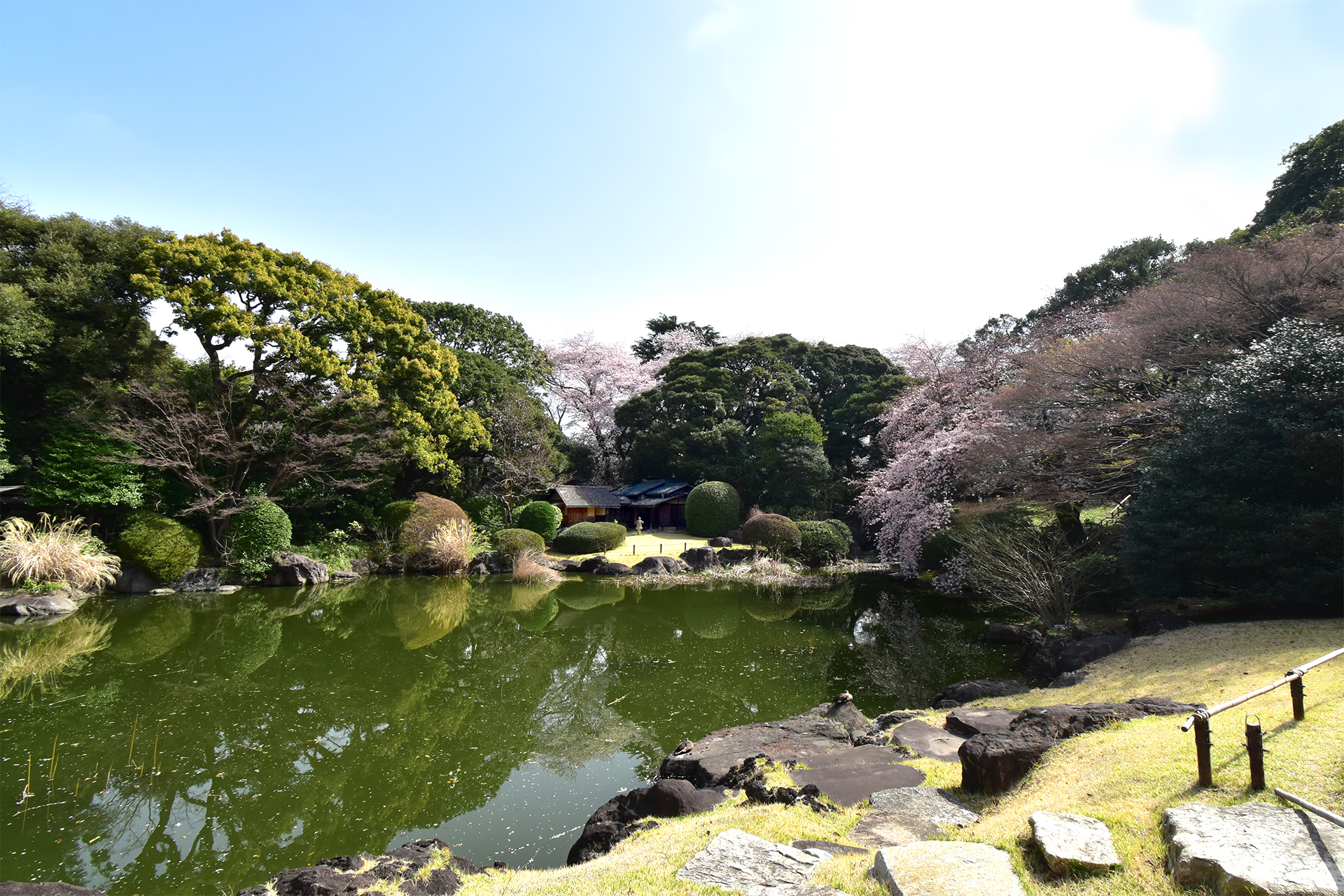
東京国立博物館の本館北側に広がる庭園は、池を中心に5棟の茶室を配し、四季折々の花や紅葉に彩られる憩いの空間です。かつてあった動植物の研究部門「天産部」の名残で、珍しい樹木や野草が植えられているのも特徴です。また、5代将軍徳川綱吉が法隆寺に献納した五重塔や、石碑や燈籠などが庭園には遺されています。
庭園内にある茶室は、茶会・句会等にご利用いただけます。茶室のご利用については施設有料貸出「茶会・句会など」をご覧ください(要事前申込、有料)。
庭園開放時間:9時30分~17時00分
庭園散策マップ(PDF,
春草廬(しゅんそうろ)
江戸時代、河村瑞賢(かわむらずいけん1618~1699)が摂津淀川改修工事の際に建てた休憩所で、その後大阪へ、さらに原三渓(1863~1939)によって横浜の三渓園に移され、昭和12年(1937)に埼玉県所沢市にある松永安左エ門(耳庵・1875~1971)の柳瀬荘内に移築されました。昭和23年(1948)に柳瀬荘が当館に寄贈され、昭和34年(1959)に春草廬は現在の位置に移されました。入母屋(いりもや)の妻に掲げられた「春草廬」の扁額は、能書家として知られる曼殊院良尚法親王(1622~1693)の筆で、三渓が耳庵に贈ったものです。木造平屋建て、入母屋造、茅葺き、座敷は5畳と3畳からなります。

転合庵(てんごうあん)
小堀遠州(こぼりえんしゅう 1579~1647)が桂宮から茶入「於大名(おだいみょう)」を賜った折、その披露のために京都伏見の六地蔵に建てた茶室です。1878年、京都・大原の寂光院に伝わっていた転合庵を、渡辺清(福岡県令、福島県知事、男爵)が譲り受け、東京麻布区霞町に移築。その後、三原繁吉(日本郵船の社員、浮世絵コレクター)へと所蔵者が変わっています。三原は茶入「於大名」も入手し、茶室転合庵とゆかりの茶入「於大名」がここで再び巡り合うこととなりました。その後、塩原又策(三共株式会社 今の第一三共の創業者)を経て、妻の塩原千代から昭和38年(1963)に茶入とともに当館に寄贈されました。

六窓庵(ろくそうあん)
慶安年間(1648~1652)に奈良の興福寺慈眼院(じげんいん)に建てられたもので、もとは興福寺大乗院内にあり現在奈良国立博物館に移された八窓庵、東大寺塔頭四聖房の隠岐録(おきろく)とともに大和の三茶室といわれました。明治8年(1875)に博物館 が購入、解体輸送中に伊豆で船が難破しましたが、幸い材は流失をまぬがれて明治10年(1877)に当館に移築されました。その後、第二次大戦中再び解体され疎開しま したが、昭和22年(1947)9月、数寄屋の名工木村清兵衛により現在の位置に再建されたものです。入母屋造、茅葺きで席は三畳台目出炉、金森宗和(1584~1656)好み。水屋、寄付、腰掛などは明治14年(1881)に古筆了仲(こひつりょうちゅう)によって設計、増築されたものです。
にじり口にある手水鉢(ちょうずばち)は四方仏水盤といわれる形式のもので、延長3年(925)関白 藤原忠平が建立した法性寺(山城国)の石塔のひとつでした。その後、銀閣寺を経て所有者が幾人か変わり、明治18年(1885)に当館の所有になりました。
にじり口にある手水鉢(ちょうずばち)は四方仏水盤といわれる形式のもので、延長3年(925)関白 藤原忠平が建立した法性寺(山城国)の石塔のひとつでした。その後、銀閣寺を経て所有者が幾人か変わり、明治18年(1885)に当館の所有になりました。
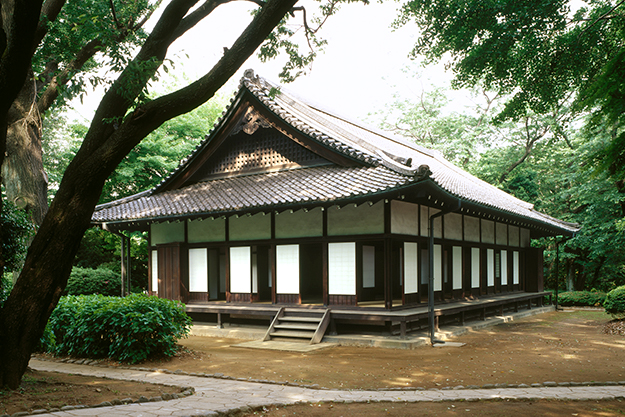
応挙館(おうきょかん)
尾張国(現在の愛知県大治町)の天台宗寺院、明眼院(みょうげんいん)の書院として寛保2年(1742)に建てられ、後に東京品川の益田孝(鈍翁・ 1848~1938)邸内に移築、昭和8年(1933)当館に寄贈され、現在の位置に移されました。室内に描かれている墨画は、天明4年(1784)、円山応挙(まるやまおうきょ、1733~1795)が明眼院に眼病で滞留していた際に揮亳したものであると伝えられています。松竹梅を描いた床張付がのこされています。
墨画は保存上の理由から収蔵庫で保管されていますが、2007年、最新のデジタル画像処理技術と印刷技術を駆使した複製の障壁画が設置され、応挙揮毫当時の絵画空間が応挙館に再現されました。
木造平屋建て、入母屋造、瓦葺き、間口15m、奥行き9m、2室、廻り廊下を巡らしています。
墨画は保存上の理由から収蔵庫で保管されていますが、2007年、最新のデジタル画像処理技術と印刷技術を駆使した複製の障壁画が設置され、応挙揮毫当時の絵画空間が応挙館に再現されました。
木造平屋建て、入母屋造、瓦葺き、間口15m、奥行き9m、2室、廻り廊下を巡らしています。
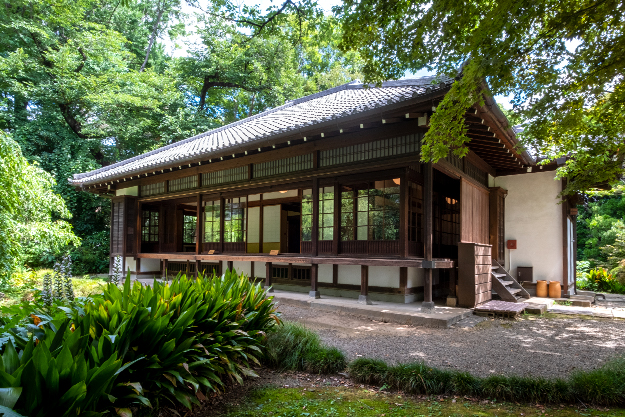
九条館(くじょうかん)
もと京都御所内の九条邸にあったものを東京赤坂の九条邸に移した建築で、当主の居室として使われていました。昭和9年(1934)九条家から寄贈され、現在の位置に移築されました。床張付、襖などには狩野派による楼閣山水図が描かれており、欄間にはカリンの一枚板に藤花菱が透かし彫りされています。
木造平屋建て、瓦葺き、寄棟造、間口15m、奥行き10m、2室、廻り廊下を巡らしています。
木造平屋建て、瓦葺き、寄棟造、間口15m、奥行き10m、2室、廻り廊下を巡らしています。
文化財、記念碑
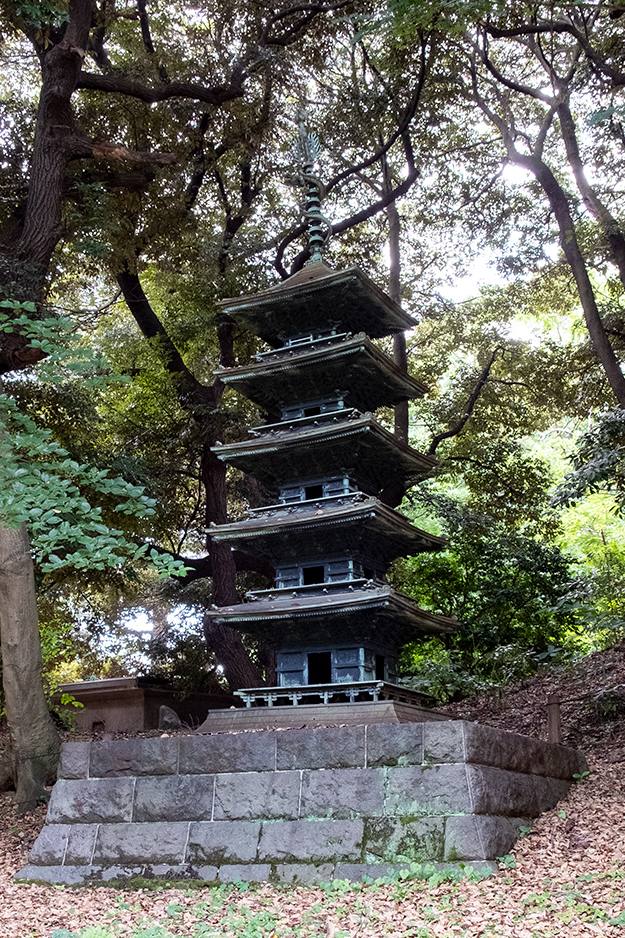
五重塔
高さ5.7mの銅製の塔。最上部の相輪には龍が絡み付き、垂木(たるき)、斗拱(ときょう)の組み物の細部まで入念に作られています。基壇に第5代将軍徳川綱吉(1646~1709)が法隆寺に奉納した旨の銘文「大和国法隆寺元禄元年十二月日常憲院徳川綱吉」が線刻されています。綱吉の存命中に、院号と俗名を併記することは一般的にないため、没後奉納時の年号と施主の銘文が書き加えられたのでしょう。

第二回内国勧業博覧会の碑
明治政府は勧業政策の一環として博覧会を開催、その第一回から第三回の会場が上野公園でした。明治10年(1877)の第一回博覧会では、本館北側のバルコニーのあたりに、日本で初めて美術館という名の煉瓦造りの建物が建てられました。この美術館の前面にジョサイア・コンドル(イギリス 1852~1920)設計の博物館旧本館が建てられ、明治14年の第二回内国勧業博覧会で使用されました。第一回は会期102日、入場者数は45万人を超え、第二回は会期122日、入場者数は82万人に上りました。博覧会は産業の振興におおいに役立っただけでなく、美術作品の出品も多く美術の振興にも寄与 しました。ちなみに、博覧会への出品物は特別に購入予算が計上されて博物館に買い上げられており、現在も明治期の工芸コレクションの重要な一部分になっています。当館に碑が残っているのは、この第二回のみです。

町田久成の碑
初代博物局長(館長)町田久成(1838~1897)の顕彰碑です。町田久成は天保9年(1838)薩摩(現在の鹿児島県)に生まれました。19歳で江戸に 出て学び、慶応元年(1865)に渡英、大英博物館などを訪れ日本での博物館創設を志し、帰国後初代博物局長として日本の博物館の基礎を築きました。文化 財調査や保護を提唱し、自らの財産を投げうって書・古美術品を買い求め文化財の散逸を防ぐことにも尽力しました。明治15年(1882)に退職、仏門に入り、明治30年(1897)9月15日上野で没しました。寛永寺津梁院(しんりょういん)に墓があります。

陶製の燈籠
第四代清水六兵衛(1848~1920)の作。明治41年(1908)の銘があります。昭和13年(1938)に五代六兵衛から当館に寄贈されました。

有馬家の墓石
東京国立博物館は寛永寺の境内であった土地に建てられたもので、庭園ももとは寛永寺の一部でした。当時の面影を今に伝えるものはわずかしかありませんが、そのひとつが、越前丸岡藩主有馬家の墓石です。記録には明治15年(1882)から19年(1886)にかけて、公園として整備するために博物館敷地内の墓所が整理されたとあります。なぜこれらの墓石だけがここに残されたのかはわかっていません。
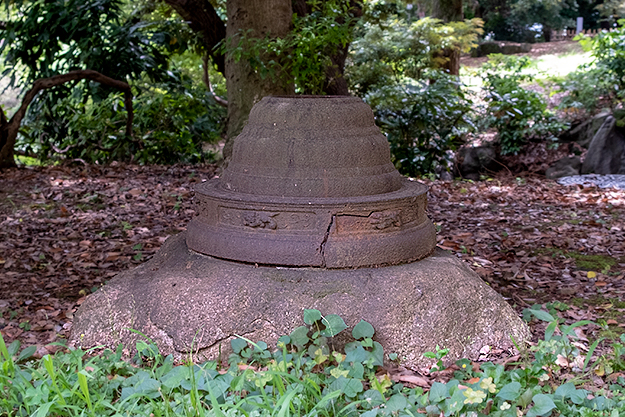
鉄燈籠
石の台に据えられた鉄製の燈籠。火袋は松皮菱を透かし、竿には雲龍文を鋳出しています。しかし、鉄製のため錆が著しく付き、昭和57年(1982)1月の台風で、竿から上が倒壊し、現在各部は別に保管しています。今は基壇だけが、そのままの状態でおかれています。銘文はありませんが、作者は茶の湯釜師として有名な江戸名越家の6代目、名越建福(なごし けんぷく、1819没)と伝えています。
